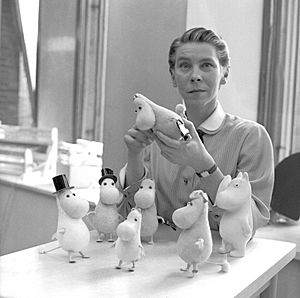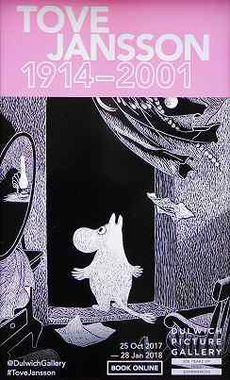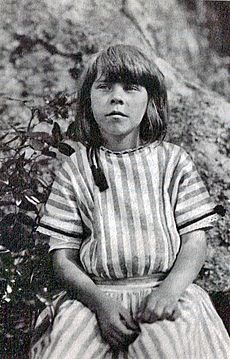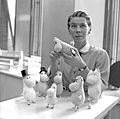Tove Jansson facts for kids
Quick facts for kids
Tove Jansson
|
|
|---|---|

Jansson in 1956 with moomintroll dolls made by Atelier Fauni
|
|
| Born | Tove Marika Jansson 9 August 1914 Helsinki, Grand Duchy of Finland, Russian Empire |
| Died | 27 June 2001 (aged 86) Helsinki, Finland |
| Occupation | Artist, writer, painter |
| Language | Swedish |
| Nationality | Finnish |
| Notable works | The Moomins The Summer Book 5/5 |
| Notable awards | Hans Christian Andersen Award 1966 Order of the Smile 1975 Pro Finlandia 1976 |
| Partner | Tuulikki Pietilä |
| Signature | |
Tove Marika Jansson (Swedish pronunciation: [ˈtuːve ˈjɑnson]; 9 August 1914 – 27 June 2001) was a famous Finnish artist and writer. She spoke Swedish, which is one of Finland's official languages. Tove was a talented painter, illustrator, and author. She is best known for creating the beloved Moomins books.
Tove grew up with artistic parents. She studied art in Stockholm, Helsinki, and Paris between 1930 and 1938. Her first art show was in 1943. At the same time, she wrote stories and articles. She also designed pictures for book covers. Tove continued to work as both an artist and a writer throughout her life.
Her Moomin books for children began in 1945 with The Moomins and the Great Flood. The next two books, Comet in Moominland and Finn Family Moomintroll, became very popular. In 1966, she won the Hans Christian Andersen Medal for her children's books. The Moomins also became a comic strip, which Tove first drew herself. In 2016, she was honored in The Will Eisner Award Hall of Fame for her comic work.
Later in her life, Tove Jansson also wrote books for adults. These included six novels and five collections of short stories. One of her most famous adult books is The Summer Book.
Contents
Tove Jansson's Early Life
Tove Jansson was born in Helsinki, Finland, on August 9, 1914. At that time, Finland was part of the Russian Empire. Her family was part of the Swedish-speaking group in Finland. They were a very artistic family. Her father, Viktor Jansson, was a sculptor. Her mother, Signe Hammarsten-Jansson, was a graphic designer and illustrator from Sweden.
Tove's brothers also became artists. Per Olov Jansson became a photographer, and Lars Jansson became a writer and cartoonist. The family lived in Helsinki. But every summer, they rented a small house on an island near Porvoo. This island, and the Söderskär Lighthouse, gave Tove many ideas for her later stories, like Moominpappa at Sea.
Tove went to school in Helsinki. Then she studied art in Stockholm from 1930 to 1933. She also studied at the Finnish Academy of Fine Arts in Helsinki from 1933 to 1937. Finally, she studied art in Paris in 1938. She showed her artwork in exhibitions during the 1930s and early 1940s. Her first solo art show was in 1943.
When Tove was 14, she wrote and drew her first picture book. It was called Sara and Pelle and Neptune's Children. It was published in 1933. She also sold drawings to magazines in the 1920s.
During the 1930s, Tove traveled to many countries in Europe. She used her travel experiences in her short stories and articles. She also drew pictures for these writings. They were published in magazines and newspapers. Tove also designed many book covers, advertisements, and postcards. She drew illustrations for Garm, a Finnish-Swedish magazine that made fun of political ideas.

Tove Jansson met her lifelong partner, Tuulikki Pietilä, during her studies. The two women worked together on many projects. One project was a model of the Moominhouse. This model is now on display at the Moomin Museum in Tampere.
Tove Jansson's Creative Work
The Moomin Stories
Tove Jansson is most famous for writing the Moomin books. She created the Moomins, who are a family of friendly trolls. They are white, round, and look a bit like hippopotamuses with big noses.
The first Moomin book, The Moomins and the Great Flood, was written in 1945. It introduced Moominmamma and Moomintroll. Most of the other main characters appeared in the next book. So, the first book is often seen as a start to the main series. This first book was not very popular at first. But the next two Moomin books, Comet in Moominland (1946) and Finn Family Moomintroll (1948), made Tove famous. The original name of Finn Family Moomintroll in Swedish means The Magician's Hat.
The Moomin books changed over time. The first books, written after World War II, were adventure stories. They included floods, comets, and magical events. The Moomins and the Great Flood tells about Moominmamma and Moomintroll escaping through a dark forest. In Comet in Moominland, a comet almost destroys Moominvalley. Some people think this story was about the fear of nuclear weapons at the time. Finn Family Moomintroll is about adventures that happen when a magic hat is found.
The Exploits of Moominpappa (1950) tells about Moominpappa's exciting younger days. Moominsummer Madness (1955) makes fun of theater. The Moomins find an empty theater and put on a play.
Besides the Moomin novels, Tove Jansson also wrote and drew four popular picture books. These include The Book about Moomin, Mymble and Little My (1952) and Who Will Comfort Toffle? (1960). As the Moomins became more famous, Tove revised and republished two of her earlier novels.
Many Moomin characters were inspired by people Tove knew. For example, the character Too-Ticky in Moominland Midwinter was inspired by Tove's partner, Tuulikki Pietilä. Moomintroll and Little My are often seen as characters that show parts of Tove's own personality. Tove even called Moomintroll her "alter-ego," meaning a part of herself.
The Moomin family is also very similar to Tove's own family. They loved nature and lived in a free-spirited way. Tove was very close to her mother until her mother passed away in 1970. Even as an adult, they often traveled together. Moominpappa and Moominmamma are often seen as characters based on Tove's parents.
Other Books for Adults
After Moominvalley in November, Tove Jansson started writing more for adults. Her first adult novel was Sculptor's Daughter in 1968. This book was partly about her own life. After that, she wrote five more novels and five collections of short stories. The Summer Book is the most well-known of her adult books translated into English. It is a charming and simple story about a young girl and her grandmother spending the summer on an island. The girl in the story is based on Tove's niece, Sophia Jansson. The girl's father is based on Sophia's father, Lars Jansson. And the grandmother is based on Tove's mother, Signe.
Wartime Cartoons for Garm Magazine

Tove Jansson worked as an illustrator and cartoonist for a Swedish-language magazine called Garm. This magazine was known for its funny and sometimes critical drawings about politics. She worked there from the 1930s until 1953.
One of her political cartoons became famous around the world. It showed Adolf Hitler as a crying baby in diapers. Other European leaders, like Neville Chamberlain, tried to calm the baby by giving him slices of cake. These slices represented countries like Austria, Poland, and Czechoslovakia. During World War II, Finland fought against the Soviet Union. At times, Finland worked with Nazi Germany. But Tove's drawings for Garm made fun of both Hitler and Joseph Stalin. In one drawing, Stalin pulls out his sword, but it's surprisingly short. In another, many Hitlers are stealing food and art from a house. People thought Tove made Hitler look like a silly and unimportant figure.
Comic Strip Artist
The Moomintroll character first appeared in Tove Jansson's political cartoons. It was a small character drawn near her name. This early Moomin was thin and not very pretty, with a long nose and a devil-like tail. Tove said she drew the Moomins when she was young. After she had an argument about philosophy with her brother, she drew "the ugliest creature imaginable" on a wall and wrote "Kant" under it. This Moomin later became rounder and nicer looking. But in the first Moomin book, you can still see hints of that original "Kant-Moomin."
The name Moomin came from Tove Jansson's uncle. When she was studying in Stockholm, her uncle told her that a "Moomintroll" lived in the kitchen closet. He said it would breathe cold air down people's necks to stop her from taking food.
In 1952, after her Moomin books were translated into English, a British publisher asked Tove to draw Moomin comic strips. Tove had already drawn a long Moomin comic for a Swedish newspaper. So, she agreed. The comic strip Moomintroll started in 1954 in the London Evening News. Tove Jansson drew 21 long Moomin stories from 1954 to 1959. She wrote them herself at first, and then with her brother Lars Jansson. She eventually stopped drawing the daily comic strip because it took too much time away from writing books and painting. Her brother Lars took over the strip and continued it until 1975.
The comic strips were published in book form in Swedish. Books 1 to 6 have also been published in English as Moomin: The Complete Tove Jansson Comic Strip.
Painter and Illustrator
Even though she became famous as a writer, Tove Jansson thought her painting and writing careers were equally important. She painted her whole life. Her style changed from the traditional impressionism of her youth to a more modern and abstract style later on. Tove showed her artworks in exhibitions in the 1930s and early 1940s. Her first solo exhibition was in 1943. Critics generally liked her work. She continued to refine her style, making it less detailed in her 1955 exhibition. Between 1960 and 1970, Tove had five more solo exhibitions.
Tove Jansson also created many large paintings and public artworks that were ordered by others. You can still see these works in their original places. Some of these include:
- A painting in the canteen at the Strömberg factory in Helsinki (1945).
- Art at the Aurora Children's Hospital in Helsinki.
- A mural for the Helsinki City Hall restaurant. This was moved in 1974 and is now at the Helsinki Art Museum.
- Art at the Seurahuone hotel in Hamina.
- The Wise and Foolish Virgins altarpiece in Teuva Church (1954).
- Fairy-tale murals in schools and kindergartens, like the one in Pori (1984).
Besides drawing pictures for her own Moomin books, Tove Jansson also illustrated other classic books. She drew pictures for Swedish versions of J. R. R. Tolkien's The Hobbit and Lewis Carroll's The Hunting of the Snark and Alice's Adventures in Wonderland. She also illustrated her own later book, The Summer Book (1972).
Theatre Work
Many plays have been made from Tove Jansson's Moomin series. Tove herself was involved in some of these productions.
The first play was a 1949 version of Comet in Moominland performed at Åbo Svenska Teater.
In the early 1950s, Tove worked with Vivica Bandler on Moomin children's plays. In 1952, Tove designed the stage sets and costumes for a ballet called Pessi and Illusia. By 1958, Tove became more directly involved in theater. A play called Troll in the wings was produced. Tove wrote the lyrics, and Erna Tauro composed the music. The play was very successful and was later performed in Sweden and Norway.
In 1974, the first Moomin opera was created, with music by Ilkka Kuusisto.
Tove Jansson's Personal Life
Tove Jansson had several close relationships. One of her friends was the political writer Atos Wirtanen. He was the inspiration for the Moomin character Snufkin.
In 1956, Tove met her lifelong partner, Tuulikki Pietilä. Tuulikki was also an artist and was known as "Tooti." In Helsinki, they lived in separate apartments in neighboring buildings. They would visit each other through a secret attic passageway. In the 1960s, they built a house on a tiny island in the Gulf of Finland, about 100 kilometers from Helsinki. They would spend their summers there. Tuulikki Pietilä filmed many hours of their travels and summers on the Klovharu island. Several documentaries have been made from this footage, including Haru, the lonely island (1998) and Tove and Tooti in Europe (2004). Many believe that the Moomin character Too-ticky, a wise person who wears a red striped shirt, was inspired by Tuulikki Pietilä.
Tove Jansson passed away on June 27, 2001, at the age of 86, from cancer. She is buried with her parents and younger brother Lars in the Hietaniemi Cemetery in Helsinki.
Tove Jansson's Family
- Viktor Bernhard Jansson (1886–1958) - Tove's father, a sculptor.
- Signe Hammarsten (1882–1970) - Tove's mother, a graphic designer and illustrator.
- Tove Marika Jansson (1914–2001) - The famous artist and writer.
- Per Olov Jansson (1920–2019) - Tove's brother, a photographer.
- Lars Jansson (1926–2000) - Tove's brother, an author and cartoonist.
- Vivica Sophia Jansson (born 1962) - Tove's niece, who now manages the Moomin brand.
Tove Jansson's Cultural Legacy
The Hans Christian Andersen Award is a very important award for children's book writers and illustrators. Tove Jansson received the writing award in 1966.
In 1968, Swedish public TV made a documentary about Tove called Moomins and the Harbor.

Tove Jansson's books were originally written in Swedish. They have been translated into 45 languages! After the Finnish epic poem Kalevala and books by Mika Waltari, her books are the most translated Finnish works.
The Moomin Museum in Tampere shows many of Tove Jansson's Moomin artworks. There is also a Moomin theme park called Moomin World in Naantali.
Tove Jansson was featured on a special Finnish coin in 2004. This €10 coin celebrated her and Finnish children's culture. The coin showed her portrait, a city skyline, an artist's palette, and a sailing boat. The other side of the coin had three Moomin characters. In 2014, she was featured on another set of commemorative coins. She is the only person other than a former Finnish president to have two such coins. She was also on a €2 commemorative coin that was used by everyone in June 2014.
Since 1988, Finland's Post has released many postage stamps and one postal card with Moomin pictures. In 2014, Tove Jansson herself was featured on a Finnish stamp set.
In 2014, the city of Helsinki honored Tove Jansson by renaming a park in Katajanokka as Tove Jansson's Park. The park is close to where Tove lived as a child.
In March 2014, the Ateneum Art Museum held a large exhibition to celebrate 100 years since Tove's birth. It showed her work as an artist, illustrator, political cartoonist, and the creator of the Moomins. Nearly 300,000 people visited the exhibition in six months. After Helsinki, the exhibition traveled to five museums in Japan.
In 2012, the BBC broadcast a documentary about Tove Jansson called Moominland Tales: The Life of Tove Jansson.
From October 2017 to January 2018, the Dulwich Picture Gallery in the United Kingdom held an exhibition of Tove Jansson's paintings, illustrations, and cartoons. This was the first major show of her work in the UK.
In 2019, a new animated series called Moominvalley was broadcast. The writer Rhianna Pratchett wrote an article about how Tove Jansson influenced her father, Sir Terry Pratchett. He called Tove Jansson one of the greatest children's writers ever. He said her writing was one reason he became an author.
A movie about Tove Jansson's life, called Tove, was released in October 2020. It was directed by Zaida Bergroth.
Awards Tove Jansson Received
- Hans Christian Andersen Award (gold medal, 1966)
- Award for State Literature (1963, 1971 and 1982)
- Swedish Academy Finland Prize (1972)
- Order of the Smile (1975)
- Pro Finlandia Medal (1976)
- Swedish Culture Foundation Honorary Award (1983)
- The Finnish Cultural Award (1990)
- Selma Lagerlöf Prize (1992)
- The Finland Art Prize (1993)
- Mercuri International pronssiomena (1994)
- The Swedish Academy Award (1994)
- The American-Scandinavian Foundation Honorary Cultural Award (1996)
- WSOY Literary Foundation Award (1999)
- Le Prix de l'Office Chrétien du Livre
Images for kids
See also
 In Spanish: Tove Jansson para niños
In Spanish: Tove Jansson para niños











